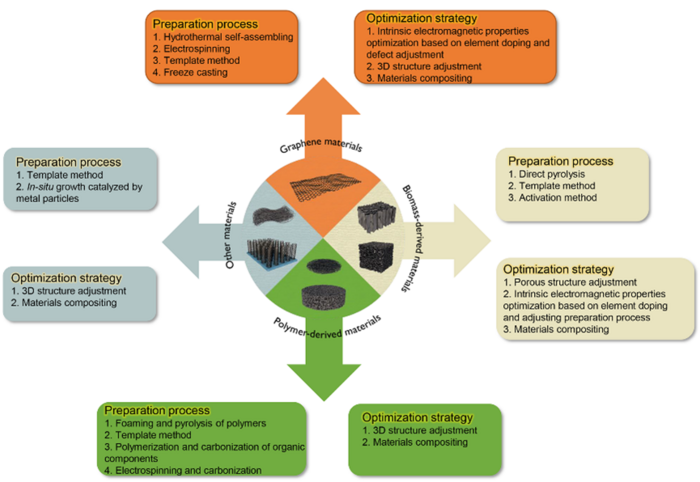Reviewed by Mila PereraSep 23 2022
Professors Jiurong Liu and Zhihui Zeng of Shandong University have published a review paper in SCIENCE CHINA Materials on three-dimensional porous carbon-based electromagnetic wave absorption materials.

Various preparation processes and optimization strategies of 3D carbon EWAMs were summarized in this figure. Image Credit: Science China Press
The creation of high-performance EWAMs has emerged as a research priority due to electromagnetic wave (EMW) pollution, which is becoming an increasingly critical problem.
Carbon-based EWAMs exhibit great physical and chemical stability as well as significant dielectric losses as a result of their high electrical conductivity. In EMW absorption, 3D porous carbon-based EWAMs have been very successful.
The 3D porous structures are anticipated to meet the target of “low density, thin thickness, wide absorption bandwidth, and strong absorption” by significantly reducing the density of the material, promoting multiple reflection and scattering of the EMW, and optimizing impedance matching.
In this review, the authors first addressed the pertinent theoretical underpinnings and evaluation techniques, including various EMW absorption mechanisms, performance indicators for EWAMs, and typical carbon-based EWAM modification techniques.
The most recent research findings for 3D porous carbon-based EWAMs were then summarized, with the material’s origin serving as the primary guiding principle. At the same time, several distinctive and original perspectives were also highlighted.
These materials were first separated into graphene materials, biomass-derived materials, polymer-derived materials, and other materials. Graphene materials stand out for their high conductivity, low density, and potent EMW absorption.
Their use is, however, constrained by their brittle construction, inappropriate impedance, and high cost. Although biomass is a cheap and easily accessible feedstock, it is challenging to guarantee the performance consistency of its products.
Porous carbons made from polymers and other industrial materials are more suited for mass production, but they still have drawbacks, including impedance mismatch. Each of these materials, therefore, has advantages and disadvantages.
Finally, the authors discussed the 3D porous carbon-based EWAMs’ current issues and future research directions. They believed that the recent research in this area had produced significant findings.
More has been done to increase the materials’ adaptability and usefulness. There have also been applications for some novel materials, such as biopolymers. Computer technology has made it easier for researchers to comprehend EMW absorption mechanisms and the applicability of EWAMs.
These materials are not currently produced in large quantities. Compositing of materials is still necessary for enhanced overall performance of carbon-based EWAMs. More importantly, more research is required on related theories.
To encourage additional studies and advance the creation of high-performance EWAMs, the authors of this review hope that it will serve as an inspiration.
Journal Reference
Han, M., et al. (2022) Recent advance in three-dimensional porous carbon materials for electromagnetic wave absorption. Science China Material. doi:10.1007/s40843-022-2153-7.